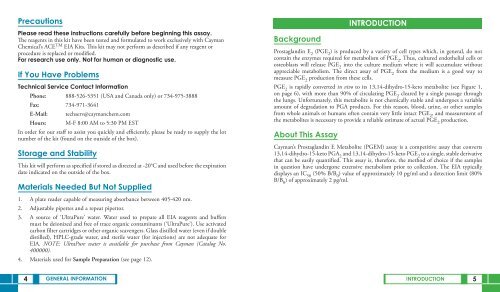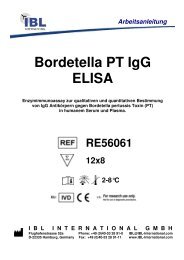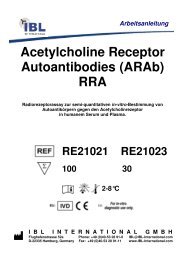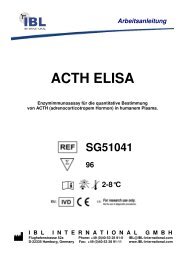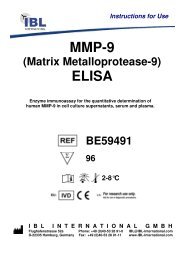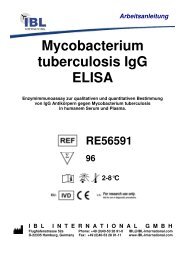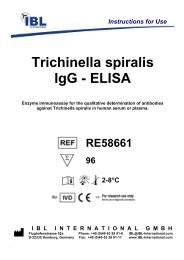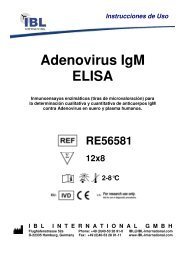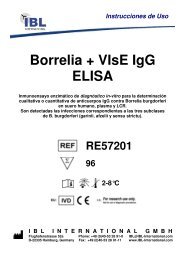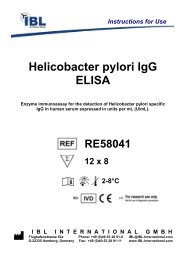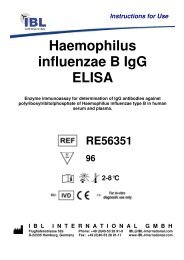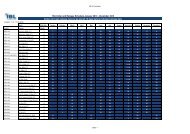Prostaglandin E2 Metabolite ELISA - IBL International
Prostaglandin E2 Metabolite ELISA - IBL International
Prostaglandin E2 Metabolite ELISA - IBL International
You also want an ePaper? Increase the reach of your titles
YUMPU automatically turns print PDFs into web optimized ePapers that Google loves.
Precautions<br />
Please read these instructions carefully before beginning this assay.<br />
The reagents in this kit have been tested and formulated to work exclusively with Cayman<br />
Chemical’s ACE TM EIA Kits. This kit may not perform as described if any reagent or<br />
procedure is replaced or modified.<br />
For research use only. Not for human or diagnostic use.<br />
If You Have Problems<br />
Technical Service Contact Information<br />
Phone: 888-526-5351 (USA and Canada only) or 734-975-3888<br />
Fax: 734-971-3641<br />
E-Mail: techserv@caymanchem.com<br />
Hours: M-F 8:00 AM to 5:30 PM EST<br />
In order for our staff to assist you quickly and efficiently, please be ready to supply the lot<br />
number of the kit (found on the outside of the box).<br />
Storage and Stability<br />
This kit will perform as specified if stored as directed at -20°C and used before the expiration<br />
date indicated on the outside of the box.<br />
Materials Needed But Not Supplied<br />
1. A plate reader capable of measuring absorbance between 405-420 nm.<br />
2. Adjustable pipettes and a repeat pipettor.<br />
3. A source of ‘UltraPure’ water. Water used to prepare all EIA reagents and buffers<br />
must be deionized and free of trace organic contaminants (‘UltraPure’). Use activated<br />
carbon filter cartridges or other organic scavengers. Glass distilled water (even if double<br />
distilled), HPLC-grade water, and sterile water (for injections) are not adequate for<br />
EIA. NOTE: UltraPure water is available for purchase from Cayman (Catalog No.<br />
400000).<br />
4. Materials used for Sample Preparation (see page 12).<br />
Background<br />
INTRODUCTION<br />
<strong>Prostaglandin</strong> E 2 (PGE 2 ) is produced by a variety of cell types which, in general, do not<br />
contain the enzymes required for metabolism of PGE 2 . Thus, cultured endothelial cells or<br />
osteoblasts will release PGE 2 into the culture medium where it will accumulate without<br />
appreciable metabolism. The direct assay of PGE 2 from the medium is a good way to<br />
measure PGE 2 production from these cells.<br />
PGE 2 is rapidly converted in vivo to its 13,14-dihydro-15-keto metabolite (see Figure 1,<br />
on page 6), with more than 90% of circulating PGE 2 cleared by a single passage through<br />
the lungs. Unfortunately, this metabolite is not chemically stable and undergoes a variable<br />
amount of degradation to PGA products. For this reason, blood, urine, or other samples<br />
from whole animals or humans often contain very little intact PGE 2 , and measurement of<br />
the metabolites is necessary to provide a reliable estimate of actual PGE 2 production.<br />
About This Assay<br />
Cayman’s <strong>Prostaglandin</strong> E <strong>Metabolite</strong> (PGEM) assay is a competitive assay that converts<br />
13,14-dihydro-15-keto PGA 2 and 13,14-dihydro-15-keto PGE 2 to a single, stable derivative<br />
that can be easily quantified. This assay is, therefore, the method of choice if the samples<br />
in question have undergone extensive metabolism prior to collection. The EIA typically<br />
displays an IC 50 (50% B/B 0 ) value of approximately 10 pg/ml and a detection limit (80%<br />
B/B 0 ) of approximately 2 pg/ml.<br />
4 GENERAL INFORMATION INTRODUCTION 5


